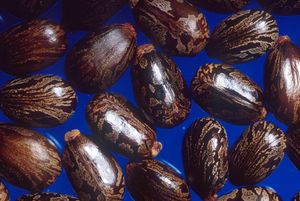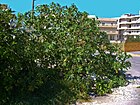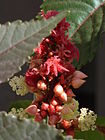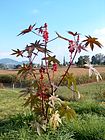Note: This is a project under development. The articles on this wiki are just being initiated and broadly incomplete. You can Help creating new pages.
Difference between revisions of "Ricinus communis - Gandharvataila"
(→Identification) |
(→References) |
||
| Line 79: | Line 79: | ||
<ref name="chemical composition">[https://www.sciencedirect.com/science/article/pii/S0378874112006393?via%3Dihub "sciencedirect"]</ref> | <ref name="chemical composition">[https://www.sciencedirect.com/science/article/pii/S0378874112006393?via%3Dihub "sciencedirect"]</ref> | ||
| − | <ref name="Leaf">[https:// | + | <ref name="Leaf">[https://indiabiodiversity.org/species/show/230990 "Cultivation details"]</ref> |
<ref name="Ayurvedic preparations">[https://easyayurveda.com/2014/12/12/castor-benefits-use-research-side-effects/ "Ayurvedic preparations"]</ref> | <ref name="Ayurvedic preparations">[https://easyayurveda.com/2014/12/12/castor-benefits-use-research-side-effects/ "Ayurvedic preparations"]</ref> | ||
Revision as of 14:30, 12 June 2019
Ricinus communis is a vegetable oil obtained by pressing the seeds of the castor oil plant. Castor oil is a colorless to very pale yellow liquid with a distinct taste and odor once first ingested.
Contents
- 1 Uses
- 2 Parts Used
- 3 Chemical Composition
- 4 Common names
- 5 Properties
- 6 Habit
- 7 Identification
- 8 List of Ayurvedic medicine in which the herb is used
- 9 Where to get the saplings
- 10 Mode of Propagation
- 11 How to plant/cultivate
- 12 Commonly seen growing in areas
- 13 Photo Gallery
- 14 References
- 15 External Links
Uses
Wounds, Cuts, Snakebites, Curing liver disorders, Skin eruptions, Blotches, Pimples, Diarrhea, Sore throats
Parts Used
Chemical Composition
Contains volatile oils, flavonoids, apigenin, luteolin, quercetin, kaempferol, tiliroside, triterpene glycosides including euscapic acid and tormentic acid, phenolic acids, and 3%–21% tannins[1]
Common names
| Language | Common name |
|---|---|
| Kannada | |
| Hindi | |
| Malayalam | |
| Tamil | |
| Telugu | |
| Marathi | NA |
| Gujarathi | NA |
| Punjabi | NA |
| Kashmiri | NA |
| Sanskrit | |
| English | Ricinus communis |
Properties
Reference: Dravya - Substance, Rasa - Taste, Guna - Qualities, Veerya - Potency, Vipaka - Post-digesion effect, Karma - Pharmacological activity, Prabhava - Therepeutics.
Dravya
Rasa
Tikta (Bitter), Kashaya (Astringent)
Guna
Laghu (Light), Ruksha (Dry), Tikshna (Sharp)
Veerya
Ushna (Hot)
Vipaka
Katu (Pungent)
Karma
Kapha, Vata
Prabhava
Habit
Identification
Leaf
| Kind | Shape | Feature |
|---|---|---|
| Simple | Alternate | palmately 6-8-lobed, peltate, to 20 x 24 cm; lobes 9-15 x 3-6 cm, lanceolate, margin coarsely serrate, apex acuminate; petiole to 18 cm long. |
Flower
| Type | Size | Color and composition | Stamen | More information |
|---|---|---|---|---|
| Unisexual | Terminal paniculate racemes | Yellow | Many | male flowers below, female ones above. Male flowers: perianth cupular, 3-5-lobed, c. 4 mm long, lanceolate; stamens many, filaments connate, repeatedly branched. Female flowers: tepals 5, subequal, c. 5 mm long, lanceolate; ovary globose, 3-locular, echinate; ovule 1-per locule; styles 3, papillose. |
Fruit
| Type | Size | Mass | Appearance | Seeds | More information |
|---|---|---|---|---|---|
| Capsule | 1.6-2 cm across | 3-lobed, prickly | Seeds oblong, smooth, marbled, carunculate. | {{{6}}} |
Other features
List of Ayurvedic medicine in which the herb is used
Where to get the saplings
Mode of Propagation
How to plant/cultivate
Landscape Uses:Border, Container, Foundation, Massing, Seashore, Specimen, Woodland garden. Prefers a well-drained moisture retentive clay or sandy loam in full sun[4]
Commonly seen growing in areas
Tall grasslands, At meadows, Borders of forests.
Photo Gallery
References
External Links
- Ayurvedic Herbs known to be helpful to treat Wounds
- Ayurvedic Herbs known to be helpful to treat Cuts
- Ayurvedic Herbs known to be helpful to treat Snakebites
- Ayurvedic Herbs known to be helpful to treat Curing liver disorders
- Ayurvedic Herbs known to be helpful to treat Skin eruptions
- Ayurvedic Herbs known to be helpful to treat Blotches
- Ayurvedic Herbs known to be helpful to treat Pimples
- Ayurvedic Herbs known to be helpful to treat Diarrhea
- Ayurvedic Herbs known to be helpful to treat Sore throats
- Herbs with Dried folaige used in medicine
- Herbs with Whole herb used in medicine
- Herbs with common name in English
- Habit - Herb
- Index of Plants which can be propagated by Seeds
- Index of Plants which can be propagated by Cuttings
- Herbs that are commonly seen in the region of Tall grasslands
- Herbs that are commonly seen in the region of At meadows
- Herbs that are commonly seen in the region of Borders of forests
- Herbs
- Euphorbiaceae








